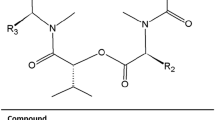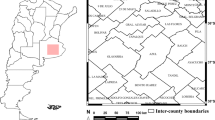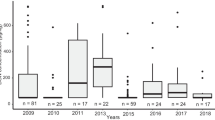Abstract
A total of 353 cereal samples from 8 German Federal States were analysed for Fusarium toxins in the 2000' survey. The level of mycotoxin contamination of the samples was higher than in the previous year due to higher moisture during flowering in some regions. Concerning deoxynivalenol (DON), the prevailing mycotoxin in all the samples, we have to consider, that 24% of the samples as well as the average concentration exceed the advisory level of 500 μg/kg. The application of Fusarium active fungicides reduced the DON level from 963 μg/kg (samples without treatment) to 630 μg/kg (all samples from treated and untreated fields). It has to be emphasised that the number of nivalenol (NIV) positive samples increased in comparison to the previous year from 9% to 17%. In addition, an increase in the level of NIV was detected, the maximum concentration in winter wheat was 3480 μg/kg. Cereals were rather moderately contaminated with zearalenone (ZEA), more than 80% of the samples contained less than 50 μg/kg.
Similar content being viewed by others
References
Ellner FM (2000) Mycotoxins — quantification, control and regulation in agricultural produce. In: Human exposure to pesticide residues, natural toxins and GMOs — real and perceived risks ed. By Altreya N and Billington R. PCBC Symposium proceedings 75: 43–53
Ellner, FM (2000) Occurrence of Fusarium toxins in the 1999' harvest. Mycotoxin Research, 16A (1): 21–25
Müller HM, Reimann J, Schumacher U and Schwadorf K (1997) Fusarium toxins in wheat harvested during six years in an area of southwest Germany. Natural Toxins 5: 24–30
Obst A, Lepschy-von Gleissenthal J and Beck R (1997) On the ethiology of Fusarium head blight of wheat in south Germany — preceding crops, weather conditions for inoculum production and head infection, proneness of the crop to infection and mycotoxin production. Cereal Res. Commun., 25 (3/2): 699–704
Schollenberger M, Suchy S, Jara HT, Drochner W and Müller H-M (1999) A survey of Fusarium toxins in cereal-based foods marketed in an area of southwest Germany. Mycopath. 147: 49–57
Author information
Authors and Affiliations
Rights and permissions
About this article
Cite this article
Ellner, F.M. Fusarium toxins in cereals — Results from eight German Federals States in 2000. Mycotox Res 17 (Suppl 1), 41–44 (2001). https://doi.org/10.1007/BF03036709
Published:
Issue Date:
DOI: https://doi.org/10.1007/BF03036709




